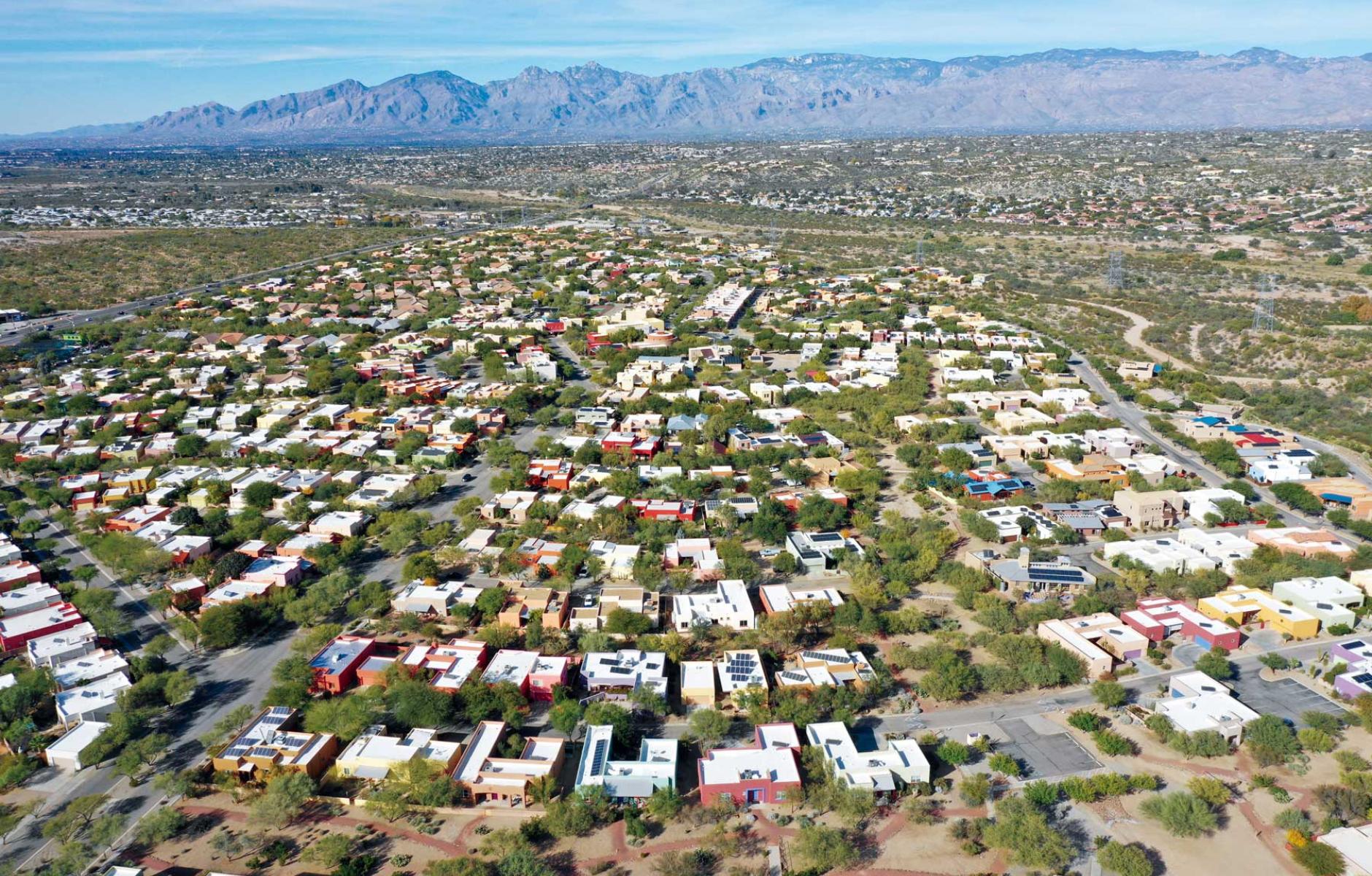
Vision of a ‘solar village,’ realized by New Urbanism
Beautiful to look at, culturally sensitive, and measurably sustainable, Civano New Town in Tucson, Arizona, was ahead of its time. Planned in 1996, Civano set a standard for what was then a radical idea—combining New Urbanism and green design.
Due to economic and ownership circumstances, only one of three planned neighborhoods was fully built out as envisioned. While the dream was truncated, this cloud has a silver lining. Civano emerged as an urban design laboratory: One neighborhood built as planned, another with green features but not New Urbanism, another entirely conventional.
As such, Civano is one of the most academically studied new urban projects, with impressive findings for climate mitigation and livability. The community’s maturation over the last 20 years vindicates the principles of New Urbanism and the Canons of Sustainable Design.

The new urbanist neighborhood consists of 645 living spaces on 345 acres, plus mixed-use neighborhood center buildings. Included are a range of public spaces, from tot lots to a 2-acre park, an extensive walking trail network, and preserved open space. The architecture is inspired by Southwestern vernacular styles. The design ensemble, from building to block to neighborhood, is unique.
“Once in a great while each of us is lucky enough to have an opportunity to clearly see the future,” said Vice President Al Gore in April of 1999. “Today, the grand opening of Civano is one of those unique times.”
Civano was the product of many years of planning, prior to New Urbanism. In the wake of the “Arab oil crisis” in the 1970s, forward-thinking Arizonans saw an opportunity to build what was originally dubbed a “solar village.” Continued advocacy over two decades resulted in the first new urban charrette in the Southwest, according to the project team. From the start, the goal was to meet aggressive standards set by the City for energy use, water use, solid waste creation, and transportation/air pollution.

Working with the developer, builders, and the City, Civano’s design and implementation achieved a series of important milestones, the team told CNU.
- As the first large-scale New Urbanist project in that part of the US, it represented an important test of the movement’s principles in an entirely new physical environment from what, at the time, was dominated by Southeastern projects.
- The Civano team studied the regional vernacular. The homes and commercial buildings in Civano combine the forms and elements of Southwestern vernacular while incorporating the latest home building techniques. The end result are homes with remarkable livability in what can be a harsh environment, while using about half the energy typical of residential and commercial buildings.
- Civano was the first project to combine the protocols of New Urbanism with an ambitious set of environmental goals and community building. With measurable results demonstrating a notably smaller heat island effect and documented radically lower home energy bills; Civano offers lessons for New Urbanist community building that will become ever more critical as the climate crisis escalates. The reported total monthly energy bill of one resident averages about $22.
- Civano is a case study in the challenges of doing a project on this scale as a public/private partnership, and in how to engage entitlement agencies when promoting innovative approaches to planning, zoning, and design issues. Locally, Civano’s ultimate success in the marketplace (although there were financial struggles along the way) has helped legitimize reform of conventional zoning, engineering, and planning practices.

“At a minimum, sustainable development requires community support; Civano owes its very existence to the countless individuals who imagined, persisted, and achieved this vision,” says the project manager for the City of Tucson. “Nevertheless, the social accomplishments alone were insufficient to assure its success. Without the exquisite urban design that so deeply understood and gracefully expressed Civano’s spirit, it might remain just a dream.”






Civano New Town
- Moule & Polyzoides, Architects and Urbanists: Principal firm
- Lee Rayburn, CDC Partners: Client
- DPZ CoDESIGN: Charrette convener and partner
- Wayne Moody, Planner/Community Design Associates: Charrette convener and partner
- Tom Lodge, managing partner, MMLA: Civil engineer
- John Jones: Director, Office of Special Projects, City of Tucson
- John Laswick: Project manager, Office of Special Projects, City of Tucson
2022 Charter Awards Jury
- Andrew von Maur (chair), Professor of Architecture at Andrews University in Berrien Springs, Michigan
- Maria Fernanda Sanchez, Co-Founder and Director of Estudio Urbano in Guatemala City, Guatemala
- Wendell Joseph, Project Planner with Toole Design Group in Boston, Massachusetts.
- Jaime Correa, Director of the Undergraduate Program and Associate Professor in Practice at the University of Miami School of Architecture, Coral Gables, Florida
- Megan O’Hara, Principal, Urban Design Associates in Pittsburgh, Pennsylvania







